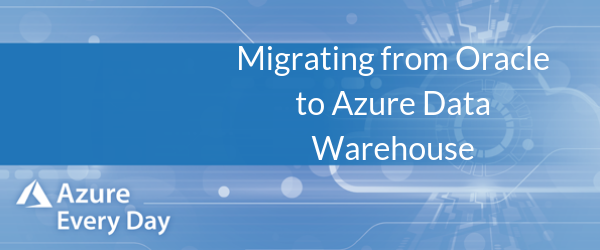Migrating from Oracle to Azure Data Warehouse


In this post, I’d like to tell you a story about a customer who chose to migrate from Oracle to Azure Data Warehouse and tell you their reasons for doing so, as well as the benefits they’re seeing after making the move.
Our first step in helping on any migration journey is to look at what a client’s current environment looks like. In this case, they were feeling the pain of peak usage times slowing down their business users and not being able to react in the way they wanted to.
This pointed to an underlying problem around the need to refresh their cluster and the tooling around that. They realized that just upgrading and refreshing that infrastructure and server set was not going to give them a great advantage – it may solve this one performance problem, but it would not help with the goal to move forward.
Another pain point was not being able to staff DBAs and developers to maintain the environment they already had, which again refreshing their environment would do nothing to help. In addition, was the expense of the environment. Consideration was taken into the cost of the licensing and the hardware required to run the super-cluster. They were looking to get out of the whole hardware business.
All these initiated a process of updating a corporate strategy to move to the cloud and what would it mean to do so. As they were already in an Oracle super-cluster, why not move to the Oracle cloud? That move would not offer a complete solution that they wanted for their business users.
Next, they looked at Google and did not like some of the cost modeling and the way the data was stored was unclear. This brought them to look at Azure. They saw that Platform as a Service (PaaS) met their needs around the idea of not having hardware. Azure Data Warehouse as a PaaS solution would contain and optimize the data they had which was 30-40 terabytes.
They also wanted an integrated identity management solution. They could get this with Azure Active Directory integrated into the platform along with what they would get from the integration with their on-premise solution.
One of the most important steps is taking the time to look at what the future would be like after a migration. When this customer looked at the data they had and the big data opportunities, they realized that Azure gave them the ability to integrate big data solutions on platforms like Azure Data Lake Store and Databricks, that can leverage the platform that they’re already moving to and allow them to expand.
In our work with them we started the discovery process to dig into details and find the pieces they needed to fix. We ran SSMA (SQL Server Migration Assistant) so we could look at their Oracle environment and evaluate code that didn’t translate directly, such as PDL SQL code or embedded Java, so we cold mitigate that.
When we built the solution out, we were able to leverage Azure Data Warehouse for the primary data solution. We were loading with Azure Data Factory and supporting that load with Logic Apps. We utilized Data Lake Store to land data initially, stage some data and help in the migration process since we were able to load data into the Data Lake Store and use it to load the Data Warehouse quickly.
One of the biggest challenges in this type of migration is moving from an SMP architecture to an MVP architecture and dealing with things like concurrency issues and sizing it correctly in a platform solution. By landing on a larger solution, the client was able to get what they wanted from concurrency and performance, but that’s only part of the story.
The biggest part of the story is, after we got them running, what did they gain?
- They found freedom from Oracle licensing – enough said.
- Platform as a Service brought them better total cost of ownership and faster time to market for new solutions for their business.
- They were better positioned to use different analytic capabilities. Having things like Cognitive Services and the rest of the platform services at their disposal.
Making the choice to move their platform to Azure Data Warehouse and all the advantages that come with that, they can now better meet the needs of their business. So, if you’re looking at your environment and trying to decide if you should go to Azure Data Warehouse, think with the end in mind – how will your business benefit by making this move?
My story today should be proof. Our customer was able to meet their business needs faster, more cost effectively and provide additional analytics that they could never have dreamed of if they hadn’t made the move.
We’ve helped so many of our customer to migrate to Azure and gain all the advantages there, we can help you too. Click the link below or contact us—we’d love to help get you into the Azure cloud.
Sign-up now and get instant access
ABOUT THE AUTHOR
Free Community Plan
On-demand learning
Most Recent
private training




.jpg?width=406&name=Eans%20YouTube%20Thumbnails%20(2).jpg)


-1.png)
Leave a comment